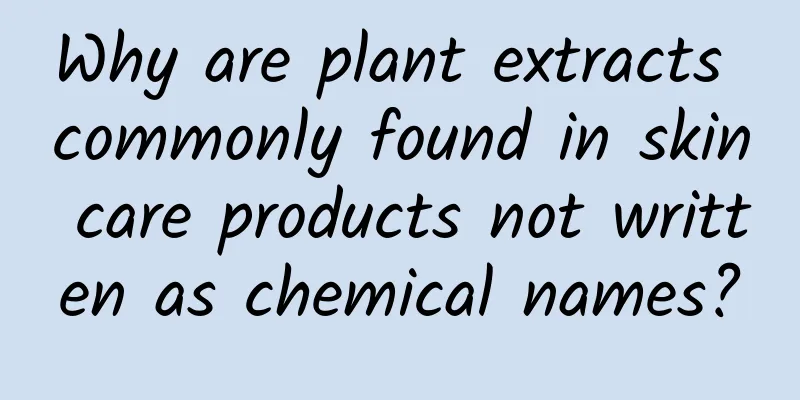Why are plant extracts commonly found in skin care products not written as chemical names?

|
Skin care products have become a necessity in our daily life. Perhaps you have already discovered that ×× plant extracts are often seen in the ingredients of skin care products. Some friends have asked, why not write them as standard chemical names, such as butylene glycol, titanium dioxide, etc.? Let’s talk about this issue with you today. 01 Why not write the chemical name? There are two main reasons why "xx plant extract" is written instead of the standard chemical name: 1. The ingredients are too complex to be labeled. Many people are used to labeling chemical names. This is because many skin care product ingredients are pure chemical ingredients produced by chemical industry, so a single ingredient can be labeled. However, this is not possible for plants because they contain too many components. Take licorice as an example. Preliminary identification has revealed more than 170 chemical components, including 61 triterpenes, 106 flavonoids and their derivatives [1]. If a single ingredient has not been completely purified, it is actually illegal to label it as such. 2. Multi-component interaction is an important advantage of plant extracts. Plants are organisms, and the various components inside them do not exist in isolation, but form a certain degree of interaction, which has both synergistic and antagonistic effects. For example, plant chelation is a chemical process in which plant compounds can combine with metal elements to form complexes. Similar interactions are also an important factor in the effectiveness of plant extracts. In addition, there is another interesting question. Suppose a plant extract is successfully identified, you can imagine how complicated this table is. For example, if I put the flavonoids identified in licorice in it, it would look like this. If you write down other ingredients, it will probably be a thick instruction manual. 02 Are there no ingredients in plant extracts that can be described by chemical names? Of course, you may say that since plant extracts have complex ingredients and are difficult to label individually, is it possible to find effective single ingredients in plant extracts that can be directly expressed using standard chemical names? The answer is of course yes. For example, Glabridin is a typical case that fully meets the requirements of the question. First of all, glabridin is a plant extract. Glabridin is obtained from the perennial herb Glycyrrhiza glabra L., which is mainly distributed in Northeast, North and Northwest my country. It was included in the scope of special plants by the ancients very early. Modern plant chemistry has found that glabridin contains rich flavonoids, isoflavones, triterpenoid saponins, phytosterols and other beneficial ingredients. Glabridin is extracted from it, so it is called glabridin. However, glycyrrhizin is different from general licorice glaze extract in that it is a single ingredient, rather than general extracts whose ingredients are unclear, poorly researched, and difficult to measure the effects of mixed ingredients. Secondly, the chemical identification of glabridin has been completed. Glabridin isolated from Glycyrrhiza glabra has already undergone standard chemical identification and has been assigned a separate CAS number 59870-68-7 by the Chemical Abstracts Service (CAS) under the American Chemical Society, which is an internationally accepted method for registering, identifying and distinguishing single chemical components in chemistry. We can see the corresponding chemical information about glabridin above. For example, the molecular formula of glabridin is C20H20O4, and its molecular structure is That is 4-[(3R)-8,8-Dimethyl-3,4-dihyd. Of course, since it is a molecule with a clear chemical structure, the corresponding other chemical information has naturally been interpreted, including physical and chemical properties such as molecular weight, density, melting point, boiling point, etc., which have been clearly interpreted. The corresponding spectrum information has also been revealed: Third, glabridin has achieved a high purity of 99%. I believe everyone understands that high purity often means better, but in fact, improving purity is a very difficult scientific and technological problem. There are many reasons behind this. First, the properties of the substance will affect the purification. For example, the stability of the substance is actually related to the conditions. Changes in conditions will increase the difficulty of purification. Secondly, the characteristics of impurities will also affect the difficulty of purification. The content and properties of impurities will greatly increase the difficulty of purification. In addition, the purification method will also affect the purification efficiency. Because of this, obtaining high-purity ingredients is often a huge technical challenge. For example, the anhydrous ethanol that everyone is familiar with actually does not reach 100% purity. For glabridin, purification has always been a difficult problem that the industry has been trying to overcome, and every breakthrough in purification is a great help to the application of this ingredient. Conventional glabridin has a low purity. In order to achieve high purity, a domestic patent provides a method for preparing high-purity glabridin by melt crystallization, and its implementation path is also relatively complicated. The first step is purification, in which the crude glabridin is dissolved and adsorbed with a macroporous adsorption resin, and then washed with ethanol and recrystallized to obtain a crude material. Next is heating and melting. The crude glabridin is added to the melting crystallizer to heat the material. The third step is cooling and crystallizing, in which the glabridin in the above step is cooled and crystallized. The fourth step is sweating, which is to sweat out the fluid from the crystals. The fifth step is to melt the material by heating it up. Do you think this is the end? Of course not, you need to repeat steps 3-5 to achieve multi-level crystallization. After purification by this technology, 99% purity of glabridin can be achieved. Some people may not be very sensitive to this number. Let me introduce it to you. In chemical research, there is a term called chemical purity, which refers to the percentage of the weight of a substance in a specific chemical form to the total weight of the sample. Generally, a purity of 95% is considered purified and can be used in experiments and production. If the purity can reach 98%, this level is sufficient for chemical experiments. Through this patented method, glabridin can achieve 99%, which can be used for qualitative analysis. It is ultra-high purity glabridin, and the authoritative SGS test report also supports this. 03 What is the use of glycyrrhizin with such high purity? Some people may ask, what is the use of such high-purity glabridin? This requires us to talk about this magical substance, glabridin. Glabridin is one of the flavonoid components extracted from Glycyrrhiza glabra. Due to its extremely low content, only 100g of glabridin can be extracted from 1 ton of Glycyrrhiza glabra. However, glabridin has excellent whitening ability. Studies have found that the whitening ability of glabridin far exceeds that of familiar whitening ingredients such as niacinamide and vitamin C. Cell tests on the inhibition rate of whitening ingredients at different concentrations on tyrosinase show that at low concentrations (3.125mg/L), the inhibitory effect of glabridin on tyrosinase is 140 times that of niacinamide, 961 times that of arbutin, and 80 times that of VC [2,3,4]. This extremely excellent whitening ability also makes glabridin known as the whitening gold. It is also worth mentioning that the whitening ability of glabridin is not simply to remove melanin, but to directly penetrate into the skin to affect the activity of tyrosinase, directly inhibiting the production of melanin from the source [5]. As shown in the figure above, this is an experiment in which glycyrrhizin inhibits the activity of tyrosinase, which can produce melanin. It can significantly inhibit the activity of tyrosinase. Not only that, glycyrrhizin can also reduce the inducements of melanin production from the source, reduce the situation where stimulating factors cause the continuous production of melanin, further inhibit the production and transfer of melanin, and achieve a fundamental whitening effect. It is also worth mentioning that although glycyrrhizin has excellent whitening effects, it is not as irritating as traditional whitening ingredients and is very friendly to the skin. This is especially meaningful for Chinese people because compared with other ethnic groups, our skin generally has a thinner stratum corneum [6], is more sensitive, and is easily affected by external stimuli and produces various adverse consequences. Therefore, glycyrrhizin is more suitable for our whitening needs. Because of this, it is very important to pay attention to how to make glabridin work better. The simplest way is to increase its purity. The higher the purity, the better the effect. On the one hand, the higher the purity of glycyrrhizin, the better it can exert its effects of whitening, soothing, calming and reducing stress. On the other hand, high-purity glycyrrhizin can also reduce the impact of impurities and avoid other adverse consequences. From this, we can see that plant extracts are not an absolute option that cannot be specified in detail. With the support of modern phytochemistry, we can actually obtain truly effective ingredients from plant ingredients, and then purify them for application. Moreover, the higher the purity, the more conducive it is for the ingredients to have a better effect. However, in terms of application, purification is only the first step, and more efforts are needed to achieve greater effects. [1] Hu Jinfeng, Shen Fengjia. Overview of research on chemical components of Glycyrrhiza uralensis plants[J]. Natural Product Research and Development, 1996, (03): 77-91. [2] Wang Ruixue, Zhao Zhen, Zhong Yan, Li Xiaodi, Wang Zhiyong. Study on the synergistic effect of several commonly used whitening agents[J]. Surfactant Detergent Industry. 2014, 44(10): 572-576. [3]C. Pan, X. Li, Y. Zheng, Z. Zhang, Y. Li, B. Che, G. Liu, L. Zhang, C. Dong, HA Aisa, Z. Du and Z. Yuan, Food Science and Human Wellness, 2023, 12, 212–222. [4] Zhao Yaxin, Gao Wenyuan, Zhang Lianxue, et al. Application of licorice in cosmetics [J]. Flavor and Fragrance Cosmetics, 2010, (04): 45-48+40. [5] Pan, Chunxing, Xiaoying Liu, Yating Zheng, Zejun Zhang, Yongliang Li, Biao Che, Guangrong Liu et al. "The mechanisms of melanogenesis inhibition by glabridin: molecular docking, PKA/MITF and MAPK/MITF pathways." Food Science and Human Wellness 12, no. 1 (2023): 212-222. [6] Alaluf, Simon, Derek Atkins, Karen Barrett, Margaret Blount, Nik Carter, and Alan Heath. "Ethnic differences in epidermal melanin content and composition between photoexposed and photoprotected areas." Proceedings of the 2002 China Cosmetics Symposium (2002). |
<<: From toxic gas to life guardian, this pharmacologist justifies nitric oxide
>>: Will you become ugly if you work too long? How to say goodbye to "being ugly due to fatigue"?
Recommend
Technology News丨Omicron strain may contain cold virus gene fragments; South Korea's artificial sun is 8 times hotter than the real sun
【Today’s cover】 Zhegu Lake is located in Cuomei C...
The stock price fell 38%. Why is JD.com’s “10 billion subsidies” not favored by investors?
In August 2012, Liu Qiangdong made a tough statem...
If the corals are gone, where will the crabs attach themselves to?
At present, global climate change, especially glo...
Touch Education debuts at China Joy B2B Pavilion to build a high-quality talent training platform
ChinaJoy is highly anticipated, and Touch Educati...
Tea-making skills have been selected as intangible cultural heritage. Why is drinking tea good for your health?
In 2022, China's traditional tea-making techn...
"Big cat"? "Freeloader"? Let's take a look at the ancient history of the "king of the grassland"
There is an animal that is both familiar and unfa...
The Gregorian calendar year 2024 is 12 days longer than the lunar calendar year of Jiachen. Why?
The Gregorian calendar year 2024 is a leap year, ...
Want to show off your grapefruit diet? Don’t be blind, listen to what the experts say
Now is the season for grapefruit, which is a grea...
How to expand keywords in Baidu bidding account?
Users' search behaviors vary, and search tend...
How can a product manager who doesn’t understand technology gain a foothold in a technology company?
[[161368]] I'm a non-technical product manage...
Chun Ge, the painter, "Basic Tutorial of Human Body Painting" - Character creation from scratch
Training course video lecture content introductio...
Video websites are accelerating their "testing the waters" and paying to watch TV shows online
"Should we charge users?" This is no lo...
Four internationalization models for Chinese technology companies
According to Bloomberg, Alibaba is preparing to i...
World Economic Forum: Digital Twin City Framework and Global Practice Report
The global digital twin market is booming. It is ...









